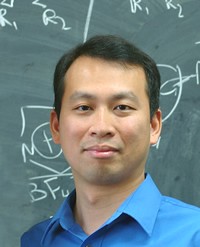【百家大讲堂】第278期:为什么会聚集诱导发光?
讲座题目:为什么会聚集诱导发光? What Leads to Aggregate-Induced Emission?
报 告 人:郑俊荣
时 间:2019年11月14日(周四)15:00-16:00
地 点:良乡校区北校区报告厅
主办单位:研究生院、化学与化工学院
报名方式:登录bob手机在线登陆微信企业号---第二课堂---课程报名中选择“【百家大讲堂】第278期:为什么会聚集诱导发光?”
【主讲人简介】

郑俊荣博士生于1973年10月,1997年本科毕业于北京大学化学学院,2000年在北京大学化学学院高分子系获得硕士学位后赴美留学,先后于美国伦斯勒理工学院化学系、斯坦福大学化学系获得硕士、博士学位,随后在斯坦福大学化学系从事博士后研究。2008年10月赴加州大学伯克利分校物理系做访问学者,2009年8月至2015年,在美国莱斯大学化学系担任助理教授一职。2015年起回北大化学院任研究员。2001年获得阿尔巴尼国际奖学金(Albany International Fellowship), 2006年获得斯坦福奖学金(Stanford Graduate Fellowship), 2007年获得分析化学与光谱协会的汤马斯赫斯费尔德奖 (Tomas Hirschfeld Scholar Award,Federation of Analytical Chemistry and Spectroscopy Societies),2008年获得韦尔奇基金会的诺曼赫克曼韦尔奇杰出青年奖(Norman Hackerman Welch Young Investigator Award,Robert A. Welch Foundation)。自2009 年起加入美国莱斯大学建立自己的实验室后,郑俊荣博士主要从事飞秒激光光谱的研究,建立起了一支在激光技术和超快激光光谱研发、理论研究及应用方面具有国际领先水平的科研团队并组建了美国Uptek Solutions公司。主持(PI)在研基金项目5项,已结题项目3项,共同主持(co-PI)基金项目1项,个人负责经费约335万美元。2011年获帕卡德科学与工程基金奖(Packard Fellowship in Science and Engineering)及美国空军研究院杰出青年奖(Air Force Young Investigator Award),2014年获斯隆研究奖(Sloan Research Fellowship)。
【讲座信息】
聚集诱导发光(AIE)克服了有机光电中常见的聚集引起的猝灭(ACQ)问题,我们通过监测频率和极化分辨的超快紫外/红外光谱和理论计算揭示了其发光机制。在AIE分子四苯基乙烯(TPE)及其衍生物的稀溶液中,我们在皮秒时间尺度内观察到了紫外线激发后伍德沃德-霍夫曼环状中间体的生成,但未在它们各自的固体中观察到。通过锥交(CI)的超快激发态环化提供了一种有效的非辐射弛豫途径。如果没有这样的反应机制,电子激发将保留在固体中,并且由于固体中分子间非密堆积排列,分子间电荷和能量转移会非常缓慢,分子将会有效发射荧光。这种机制的发现可进一步拓展用于调控不同相中生色团性质,并具有重要的应用前景。
The mechanism of aggregation-induced emission (AIE), which overcomes the common aggregation-caused quenching (ACQ) problem in organic optoelectronics, is revealed by monitoring the real time structural evolution and dynamics of electronic excited state with frequency and polarization resolved ultrafast ultraviolet/infrared spectroscopy and theoretical calculations. The formation of Woodward-Hoffmann cyclic intermediates upon ultraviolet excitation is observed within picoseconds in dilute solutions of AIE molecule tetraphenylethylene (TPE) and its derivatives but not in their respective solid. The ultrafast excited state cyclization by crossing a conical intersection (CI) provides an efficient nonradiative relaxation pathway in solutions. Without such a reaction mechanism, the electronic excitation is preserved in the molecular solids and the molecule fluoresces efficiently, aided by the very slow intermolecular charge and energy transfers due to the well separated molecular packing arrangement in solids. The mechanisms revealed can be general for tuning the properties of chromophores in different phases for various important applications.
